|
Honda Legend / Acura RL
Debut: 2005
Maker: Honda
Predecessor: Honda Legend III / Acura RL (1996)
|
|
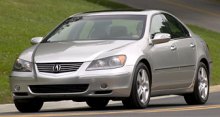 2
decades ago, Honda Legend was the first Japanese executive saloon
enjoying
the world’s recognition as well as sales success in the United States.
But since the birth of Lexus and Infiniti, the fortune of Legend
declined
gradually. Admittedly, most of that was due to its own problem. The
third
generation Legend was renamed to Acura RL in the United States, but
instead
of taking advantage of Acura's sportier image, it actually went bigger,
heavier, more luxurious and more conservative. Eventually it was
forgotten
by the market, became one of the rare failures of Honda. 2
decades ago, Honda Legend was the first Japanese executive saloon
enjoying
the world’s recognition as well as sales success in the United States.
But since the birth of Lexus and Infiniti, the fortune of Legend
declined
gradually. Admittedly, most of that was due to its own problem. The
third
generation Legend was renamed to Acura RL in the United States, but
instead
of taking advantage of Acura's sportier image, it actually went bigger,
heavier, more luxurious and more conservative. Eventually it was
forgotten
by the market, became one of the rare failures of Honda.
To revive the
Legend, Honda
developed an all-new Legend in late 2004. This car is so different from
the old car. It has an aggressive styling, a new 300hp engine, one of
the
world's most advanced 4-wheel-drive systems and a sporting philosophy
behind
it. Nothing could be more different. It immediately won appreciations
from
all over the world. At home, it is titled Japanese Car of the Year
2005.
Across the Pacific Ocean, it entered the 10 Best of Car And Driver
magazine.
The question is, how does it compare with European executive cars
headed
by BMW 5-Series? we shall find the answer in this report.
 From
design point of view, the new Legend is far from successful. Its
exterior
design is more aggressive than the old Legend, but it lacks fineness,
especially
the characterless tail and C-pillar. The whole car looks like a
pumped-up
version of the previous generation Acura TL. Without any elegant
details,
it hardly looks like a premium car. This is a big problem for a car
costing
more than BMW 530i and closer to Audi A6 V8. Remember, the Legend is
powered
by only a V6. From
design point of view, the new Legend is far from successful. Its
exterior
design is more aggressive than the old Legend, but it lacks fineness,
especially
the characterless tail and C-pillar. The whole car looks like a
pumped-up
version of the previous generation Acura TL. Without any elegant
details,
it hardly looks like a premium car. This is a big problem for a car
costing
more than BMW 530i and closer to Audi A6 V8. Remember, the Legend is
powered
by only a V6.
From packaging
point of view,
the Legend is far from modern. The way it uses space and materials is
too
inefficient. Externally, it is 9cm longer than the 5-Series, otherwise
are much the same size. Inside, it offers slightly more room for the
front
passengers, but the rear head and shoulder room are tighter. This is
especially
disappointing for a car whose engine is mounted transversely over the
front
axle, in contrast to BMW's optimized position. The same story goes at
the
trunk - the BMW can swallow 520 litres of luggage while the Honda can
carry
just 452 litres. By class standard it is rather small.
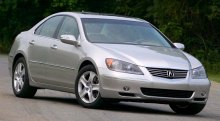 But
the biggest disappointment reveals on the scale: the Legend weighs a
hefty
1800kg, a full 300kg more than 530i !! even compare to 545i it is still
165kg heavier. 4WD system is one of the reasons, but Honda compensates
that with aluminum bonnet, front fenders, trunk lid, subframes (which
is
made by hydroform technique for even lighter), suspension arms, brake
calipers,
bumper beams…. aluminum intake manifolds, magnesium cam covers and seat
frames, and a carbon-fiber propeller shaft that transmit power to the
rear
axle ! the longer the list grows, the more you question how they can
made
the car so overweight. But
the biggest disappointment reveals on the scale: the Legend weighs a
hefty
1800kg, a full 300kg more than 530i !! even compare to 545i it is still
165kg heavier. 4WD system is one of the reasons, but Honda compensates
that with aluminum bonnet, front fenders, trunk lid, subframes (which
is
made by hydroform technique for even lighter), suspension arms, brake
calipers,
bumper beams…. aluminum intake manifolds, magnesium cam covers and seat
frames, and a carbon-fiber propeller shaft that transmit power to the
rear
axle ! the longer the list grows, the more you question how they can
made
the car so overweight.
That makes the
V6
struggling.
Viewing it in isolation, it is a remarkable engine. The all-alloy V6
runs
an optimized 60-degree incline angle, in contrast to the previous
Legend's
90 degree (which required a balancer shaft). That means it is a new
engine,
despite of the same capacity at 3.5 ltires. The cylinder heads run sohc
with 4 valves per cylinder - a Honda's trademark - and VTEC variable
valve
timing and lift (note: not the newer i-VTEC). Intake comes from a
variable
volume intake plenum. The combustion chambers run a high 11.0:1
compression
ratio. Exhaust gas flows out to a 2-stage variable muffler. All these
point
to a remarkable power output: 300 horsepower at 6200rpm, even more than
NSX by 10 horsepower.
The
new V6 has
Honda's typical
smoothness and quietness, but its 260 lbft of torque, arrives at a high
5000rpm, struggles to pull the 1800 kg Legend. This is not helped by
the
5-speed only automatic gearbox. Car magazines found it accelerates from
0-60mph in 6.5-6.7 seconds. That is adequate rather than sporting. The
new Mercedes E350 and BMW 530i with 258hp engine should achieve the
same
performance yet return lower fuel consumption. Climb up to the V8
level,
most European machines will take you there in the high 5-second. And
they
don't cost a lot more than the Legend.
That
confuse me.
On the one
hand, Legend does not have the power and low-end grunt to compete with
545i, A6 4.2 and E500. On the other hand, It does not have the
necessary
price advantage over 530i, A6 3.2 and E350, which look far more
prestige
than the Honda and have a premium brand logo on their bonnets. Acura?
who
care?
 However,
by objective measurement the Legend is on a par with its European
rivals
in many aspects. Cabin luxury is one of them. Open the door, you will
see
a stylish yet superbly built cabin. It is trimmed with plenty of wood
and
soft leather and loaded with many luxurious equipment, such as a first
class DVD stereo, voice recognition command system and the interesting
anti-noise control from Honda Inspire. This is perhaps the best aspect
of the car. However,
by objective measurement the Legend is on a par with its European
rivals
in many aspects. Cabin luxury is one of them. Open the door, you will
see
a stylish yet superbly built cabin. It is trimmed with plenty of wood
and
soft leather and loaded with many luxurious equipment, such as a first
class DVD stereo, voice recognition command system and the interesting
anti-noise control from Honda Inspire. This is perhaps the best aspect
of the car.
Handling is
also
worth praising.
Thanks to the new SH-AWD (stands for Super Handling - All Wheel Drive)
system, the Legend finally can be called a "driver's car".
SH-AWD
is a very versatile and clever 4WD system. It can vary the torque split
between the front axle and rear axle - up to 70% torque can be sent to
either axle depending on need. Moreover, it can shift up to 100% torque
between the 2 rear wheels to aid cornering, much in the same way as
Mitsubishi
Lancer Evo's AYC system. This is especially effective to eliminate
understeer,
a thing associated with Audi's Quattro and most other 4WD systems.
Without
SH-AWD, the Legend would have understeered heavily during fast
cornering.
In contrast, SH-AWD can overdrive the outside rear wheel to eliminate
understeer,
ensuring the car to corner swiftly.
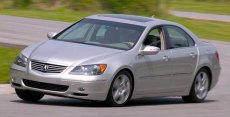 On
the road, Legend really handles amazingly good. Unlike other
front-drive
Hondas, it produces plenty of traction yet without any trace of
understeer.
The handling is fool-proof and confidence inspiring, even more so than
the rear-drive 5-Series and E-class. Nevertheless, there are a few
things
prevent it from matching those rivals: firstly, its steering is
lighter,
slower and less communicative; secondly, the softer suspension produces
more body roll; thirdly, the damping is not perfect, failing to filter
initial impact harshness very well. Lastly but not least, its hefty
weight
and 58:42 weight distribution prevent it from displaying the same
agility,
especially when compare with BMW 5-Series. On
the road, Legend really handles amazingly good. Unlike other
front-drive
Hondas, it produces plenty of traction yet without any trace of
understeer.
The handling is fool-proof and confidence inspiring, even more so than
the rear-drive 5-Series and E-class. Nevertheless, there are a few
things
prevent it from matching those rivals: firstly, its steering is
lighter,
slower and less communicative; secondly, the softer suspension produces
more body roll; thirdly, the damping is not perfect, failing to filter
initial impact harshness very well. Lastly but not least, its hefty
weight
and 58:42 weight distribution prevent it from displaying the same
agility,
especially when compare with BMW 5-Series.
The new Legend
is
not a class
leader. Despite of a powerful V6 and a sophisticated 4WD, it does not
set
new standard in performance and handling. BMW still beat it for driver
appeal, while Mercedes topples it for ride and comfort. Don’t ever
think
of matching Audi’s design and quality either.
However,
the
Legend’s biggest
problems are overweight and overpriced. Take 200 kilograms out of it,
it
could have produced storming performance. Cut US$5,000 from it, it
could
have attracted many customers from their default German choices. But
the
question is how to cut 200kg without ditching the SH-4WD? how to cut
US$5,000
without losing money?
Honda
Legend has
come to
a critical situation. Without a dedicated rear-drive platform, it had
to
derive from the company’s front-drive component set. Heavily adapted to
upgrade power, handling and comfort inevitably added weight and cost
substantially.
Take the SH-4WD for example. If you have a rear-drive platform you can
simply save the weight and cost of SH-4WD. If you are Audi, produces
200,000
or so Quattro systems a year, you can get much higher economy of scale
than SH-4WD. The same goes for the engine - when the 5-Series share the
same 3.0 inline-6 with 3-Series, 6-Series, 7-Series, X3, X5 and Z4, you
can build it cheaper than Honda’s 300hp V6. To build a premium car, a
premium
car maker has a lot of advantage over a mainstream car maker that build
only one premium car.
To
succeed, Honda
Legend
can no longer fight alone. It should either quit the premium market or
follow the footprints of Lexus and Infiniti to launch multiple premium
models base on a dedicated premium platform to share cost. But will
Honda
do that? I doubt. |
| The
above report was last updated on 27 Jan
2005. All Rights Reserved. |
2008 facelift
|
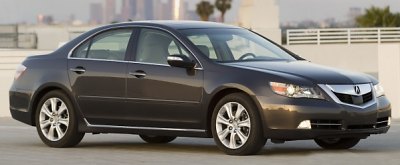
|
There are many unexplainable in this
car, such a facelift that does not lift its looks, a stronger engine
that does not result in better performance...
|
At
the time of writing, Honda has yet to launch the facelifted Legend in
Japan, but its American version, Acura RL, has gone on sale in the USA.
Although sales of the Honda flagship executive car has been
disappointing (only 6300 sold in USA last year), Honda did not pump a
lot of money into the development of this mid-life facelift. Therefore
the list of changes are quite minor and predictable. Outside, you can
see a slightly sharpened front and rear end design, a chromed grille
and larger, 18-inch wheels. They did little to alter the unattractive
looks of the old car.
In the cabin, it gets a slight upgrade in materials, sound insulation
and climate control. As the improvements are so subtle, we have to
mention trivial things such as a pair of new front seats with greater
adjustment range, a thinner rear seat designed to release more room for
rear passengers (but still too cramped) and the addition of gearshift
paddles behind the steering wheel (but the automatic gearbox is still
an outdated 5-speeder).
Under the bonnet, the previous 3.5-liter V6 has been replaced by a
larger 3.7-liter unit from Honda's MDX SUV. Still base on the
all-aluminum 60-degree SOHC VTEC architecture, but now it employs
silicone-treated aluminum cylinder liners, a higher compression ratio
(11.2:1 instead of 11.0:1) and the VTEC mechanism now serves also
exhaust valves. So it deserves 30 or 40 more horsepower, doesn't it ?
Disappointingly, for reasons we don't know, the new engine produces the
same 300 horsepower at the top end. Max torque does increases by 11
lb-ft to 271 lb-ft, and there is more torque below 3000 rpm, but that
is only enough to offset the weight increase of 50 kg, so performance
remains the same as before. In other words, slow.
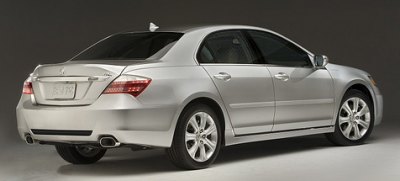
|
The RL is about as fast as BMW 530i,
slower than 535i, but drinks as much fuel as 550i !!
|
The
Acura RL is about as fast as a BMW 530i, by far slower than 535i, but
it drinks as much fuel as a 550i !! This is according to EPA test
result, which rated it at 16 mpg in city and 22 mpg on highway. In
contrast to other competitors, the mid-life facelift actually worsens
the already heavy fuel consumption of the old car, making it even more
uncompetitive these days. Even the big cars from GM, Ford and Chrysler
return better fuel economy ! What's wrong with the Japanese car maker
which made name by selling the super-frugal Civic CVCC in the last
energy crisis ?
Honda said the new 3.7-liter V6 is 8 kilograms lighter than the old
3.5-liter unit. Furthermore, the new RL has its bonnet converted to
aluminum to save weight. It should therefore achieve a better balance.
However, for another reason we don't know, its specification sheet
shows
the same weight distribution at 58:42 front to rear, too bad. The
suspensions are said to get stiffer springs and thicker anti-roll bars.
The 18-inch alloy wheels are wrapped with wider and thinner tires. The
revised SH-AWD system is said to be more responsive. Somehow, there is
no apparent improvement to its handling.
There are too many things unexplainable in this car. Honda could have
shortened the gap between the RL and its superior rear-drive premium
brand rivals, but it failed to do so. The Acura RL / Legend remains
ugly, cramped, slow and inefficient. Its handling, thanks to the
presence of SH-AWD, is still considered to be good, but it won't tempt
you away from BMW either. I think Honda's executive car has come to the
same situation like many European mainstream car makers faced early
last decade. If it cannot dedicate a premium platform to this car, it
will never satisfy those paying premium money. In the end, it will be
forced to leave the executive car segment. Think about it, Honda.
|
| The
above report was last updated on 26 Jun
2008. All Rights Reserved. |
|
|